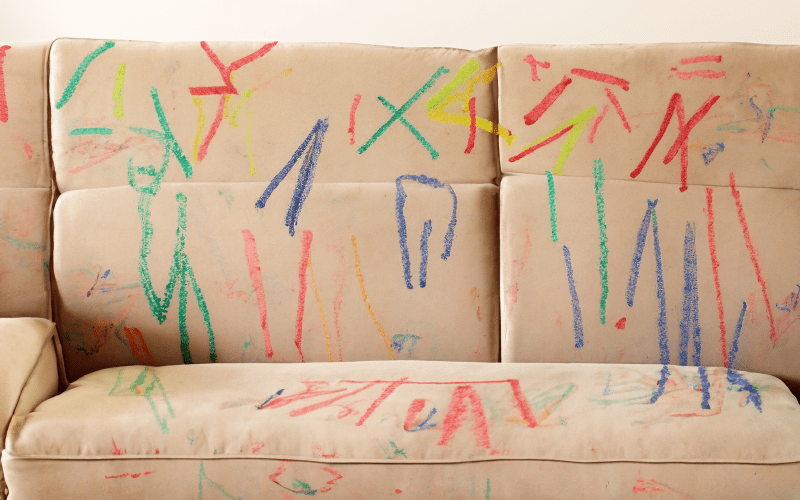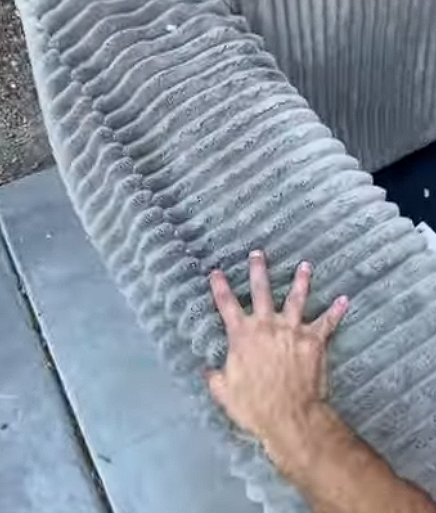Tackling Crayon Stains: Quick Solutions for Busy Households
Crayon stains are a familiar sight in many homes, particularly those with children.
Whether it’s an accidental drawing on the couch or a colorful masterpiece on the dining table, these vibrant marks can be both frustrating and daunting to remove.
Promptly addressing crayon stains is crucial, as delaying action can lead to more challenging cleanup efforts and potentially permanent damage to your furniture. With the right techniques and tools, you can restore your furniture’s appearance and maintain a clean, inviting space for your family and guests.
In this guide, we’ll explore effective methods to tackle these stains head-on, ensuring your furniture stays in top shape amidst the creative chaos of family life.
Tools You'll Need To Get Started
Understanding Crayon Stains: What They Are and How They Affect Your Furniture
Crayon stains can be particularly stubborn due to their composition, which typically includes wax, pigment, and binding agents.
When crayons come into contact with furniture surfaces, the wax can adhere strongly, making it challenging to remove. Different types of furniture finishes react uniquely to crayon stains.
For example, fabric upholstery may absorb the wax and pigment, resulting in a more profound stain, while leather can usually be cleaned with less effort, as the surface can often be wiped clean.
Wood finishes, on the other hand, may require a more delicate approach to avoid damaging the finish.
Understanding these materials will help you choose the most effective cleaning method for your specific furniture type.
How To Get Crayon Off Couch: Immediate Steps to Take After a Crayon Stain
When you discover a crayon stain on your furniture, acting quickly can make a significant difference in the removal process.
You’re probably asking yourself how do i get this crayon stain off my couch?
This initial response helps minimize the stain’s depth and prevents it from spreading further.
By addressing the crayon mark promptly, you’ll set the stage for more effective cleaning and protect your furniture from lasting damage.
Essential Tools and Materials for Crayon Stain Removal
To effectively tackle crayon stains on your furniture, having the right tools and materials on hand is crucial.
Start with a plastic scraper to gently remove excess crayon without damaging the surface.
Soft cloths are essential for blotting and cleaning, while effective cleaning solutions like rubbing alcohol, white vinegar, and dish soap can help dissolve the stain.
Baby wipes or wet wipes are great for quick cleanups and can be particularly handy for fabric surfaces. For tougher stains, a hair dryer or heat gun can be used to soften the wax before wiping it away.
Additionally, a stain remover specifically designed for furniture can provide an extra boost in your cleaning efforts, ensuring a thorough and effective cleanup.
Step-by-Step Removal Process for Fabric Upholstery
Removing crayon stains from fabric upholstery can be effective when using the right techniques.
Start by dampening a cloth or using baby wipes with dawn dish soap mixed with warm water.
Gently blot the stained area, avoiding any rubbing, which can push the stain deeper into the fabric. It’s essential to work patiently, repeating the blotting process as necessary until the stain begins to lift.
Be sure to check the fabric care label before using any cleaning solutions to prevent any damage.
Step-by-Step Removal Process for Leather Furniture
When it comes to leather furniture, crayon stains can often be removed with a gentle approach.
Begin by dampening a clean cloth with a mild soap solution—avoid using harsh chemicals that could damage the leather.
Wipe the stained area gently, taking care not to soak the leather.
After cleaning, use a dry cloth to wipe away any moisture and restore shine. Regular use of a leather conditioner can also help maintain its appearance and protect it from future stains.
Step-by-Step Removal Process for Wood Furniture
For crayon stains on wood furniture, a careful cleaning method can help preserve the finish. Start by mixing equal parts of white vinegar and olive oil, which not only cleans but also nourishes the wood.
Using a soft cloth, gently rub the stained area in the direction of the wood grain to lift the stain without scratching the surface.
It’s essential to avoid using excess moisture, as this can damage the wood.
Once the stain is removed, wipe the area with a dry cloth to restore its shine and protect it from future marks.
The Importance of Patch Testing Before You Start
Before diving into the stain removal process, it’s crucial to perform a patch test with any cleaning solution.
This step helps you determine how the material will react to the cleaner, preventing any potential damage to your furniture. Applying the cleaning solution to an inconspicuous area allows you to assess its effectiveness and safety without risking visible harm.
A simple patch test can save you time and trouble by ensuring that the chosen method is suitable for your specific furniture type.
Tips for Effective Patch Testing
To conduct an effective patch test, start by applying a small amount of the cleaning solution to a hidden spot on the furniture.
Use a cotton swab or a soft cloth for precision, ensuring you only treat a small area. Wait about 5 to 10 minutes to observe any reactions, such as discoloration, fading, or surface damage.
If the area looks unaffected, you can proceed with the cleaning process. However, if you notice any adverse effects, it’s best to try an alternative method or solution before tackling the visible stain.
Additional Methods for Tackling Stubborn Crayon Stains
When crayon stains prove stubborn, using heat can be an effective method for removal. A hair dryer or heat gun can gently soften the wax, making it easier to lift from the surface.
Hold the dryer a few inches away from the stain and use a low setting to avoid damaging the furniture. Once the wax has softened, quickly blot the area with a clean cloth to absorb the melted residue.
For particularly tough stains, commercial stain removers designed for specific materials can offer additional help.
Always read the label for recommendations and precautions, ensuring compatibility with your furniture type, and conduct a patch test before applying the product to a larger area.
Tips for Preventing Future Crayon Stains on Furniture
Preventing crayon stains on your furniture starts with proactive strategies, especially for parents and caregivers.
Designating a specific area for coloring activities can help contain any mess, minimizing the risk of marks on your furniture.
Opting for washable crayons or art supplies can also significantly reduce the chances of permanent stains, as they are easier to clean when accidents happen.
Additionally, covering furniture with slipcovers or old sheets during art time provides an extra layer of protection against potential spills and stains.
By implementing these simple tips, you can encourage creativity while keeping your living space looking its best.
Keep Your Furniture Crayon-Free
In summary, promptly addressing crayon stains on furniture is key to maintaining its appearance and longevity.
By following the outlined steps—scraping off excess crayon, using appropriate cleaning methods for various materials, and testing any solutions beforehand—you can effectively restore your furniture to its original state.
Remember, the sooner you act, the better your chances of achieving optimal results.




















